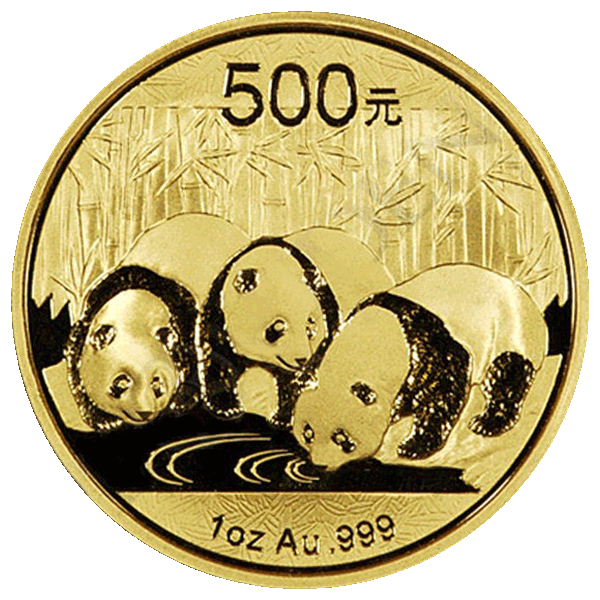Chinese CoinsMish Int'l is one of the world's most respected market makers in Chinese Coins, including panda and lunar animal issues, which are collected and appreciated by so many numismatists both in China and worldwide. Chinese coins have been a specialty of the company since shortly after the first modern Chinese issues appeared in 1979. Mr. Mish frequently travels to Asia. In turn, Chinese dealers and investors visit us often at our Menlo Park Showroom. Mr. Mish was acknowledged by the China Mint's panda designer Mr. Qian as influential in the redesigned panda coin for 2014. The Gold & Silver Panda Coin Buyers Guide, 2nd edition, acknowledges our contributions to this primary reference book. from Wikipedia: Chinese Panda Coins
China issued its first gold coins picturing an Panda design in 1982, in sizes of 1, 1/2, 1/4, and 1/10 troy oz. of 999 fine gold. Beginning in 1983 another size was added - 1/20 oz. Larger Panda coins were issued in some years, weighing 5 and 12 oz. These popular coins are issued in Prooflike Brilliant Uncirculated quality with a different design each year. A freeze of the design was announced with the 2001 issues—and thus the 2002 Pandas were identical to 2001. But collectors spoke up in behalf of annual changes, and China reverted to their original policy. There are several mints that produce these coins, including but not limited to: Beijing, Shenzhen, Shanghai and Shenyang. Unlike coins made by US mints that carry mintmarks to distinguish their origin, Chinese mints usually do not employ mintmarks. In certain years there are minor variations—in the size of the date, style of the temple, etc.—in the coin design that allow the originating mint to be determined. Chinese Lunar CoinsIn 1979, China began minting commemorative modern coins. In 1981, China began minting coins to commemorate the Chinese New Year. Typically the obverse features a historical building while the reverse features the lunar animal reproduced from historical Chinese drawings or paintings. The lunar animals are: Ox, Tiger, Rabbit, Dragon, Snake, Horse, Goat, Monkey, Rooster, Dog, Pig, Rat. Menlo Park, CaliforniaMenlo Park is an affluent town at the eastern edge of San Mateo County, in the San Francisco Bay Area of California, in the United States. It is bordered by San Francisco Bay on the north and east; East Palo Alto, Palo Alto, and Stanford to the south; Atherton, North Fair Oaks, and Redwood City to the west. Menlo Park is one of the most educated cities in the state of California and the United States, with nearly 70% of its residents having earned an advanced degree. Menlo Park had 32,026 inhabitants according to the 2010 United States Census. In addition, Menlo Park was ranked in the top 15 US cities in CNN's "Best Places for the Rich and Single" to live.
According to the United States Census Bureau, the city has a total area of 17.4 square miles (45 km2), of which 9.8 square miles (25 km2) is land and 7.6 square miles (20 km2) is water. The total area is 43.79% water.The main street in downtown Menlo Park is Santa Cruz Avenue, with the Menlo Center situated at its intersection with El Camino Real. The Menlo Park Civic Center is bounded by Ravenswood Avenue, Alma Street, Laurel Street and Burgess Drive. It contains the council offices, library, police station and Burgess Park which has various recreational facilities.
|
 The Chinese Gold Panda is a series of gold bullion coins issued by the People's Republic of China. The official mint of the People's Republic of China introduced the Panda gold bullion coins in 1982. The panda design changes every year (with a single exception) and the gold Panda coins come in different sizes and denominations, ranging from 1/20 troy oz. to 1 troy oz. (and larger ones as well).
There is also a Silver Panda series issued with the same designs as the gold Panda coins.
The Chinese Gold Panda is a series of gold bullion coins issued by the People's Republic of China. The official mint of the People's Republic of China introduced the Panda gold bullion coins in 1982. The panda design changes every year (with a single exception) and the gold Panda coins come in different sizes and denominations, ranging from 1/20 troy oz. to 1 troy oz. (and larger ones as well).
There is also a Silver Panda series issued with the same designs as the gold Panda coins.